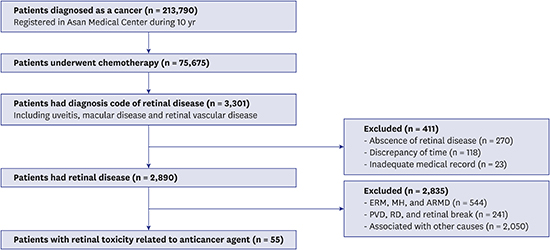1. Vizel M, Oster MW. Ocular side effects of cancer chemotherapy. Cancer. 1982; 49(10):1999–2002.

2. Schmid KE, Kornek GV, Scheithauer W, Binder S. Update on ocular complications of systemic cancer chemotherapy. Surv Ophthalmol. 2006; 51(1):19–40.

3. Al-Tweigeri T, Nabholtz JM, Mackey JR. Ocular toxicity and cancer chemotherapy. A review. Cancer. 1996; 78(7):1359–1373.

4. Liu CY, Francis JH, Brodie SE, Marr B, Pulido JS, Marmor MF, et al. Retinal toxicities of cancer therapy drugs: biologics, small molecule inhibitors, and chemotherapies. Retina. 2014; 34(7):1261–1280.
5. McKeown CA, Swartz M, Blom J, Maggiano JM. Tamoxifen retinopathy. Br J Ophthalmol. 1981; 65(3):177–179.

6. Ham DS, Lee JE, Kim HW, Yun IH. A case of cystoid macular edema associated with Paclitaxel chemotherapy. Korean J Ophthalmol. 2012; 26(5):388–390.

7. McCannel TA, Chmielowski B, Finn RS, Goldman J, Ribas A, Wainberg ZA, et al. Bilateral subfoveal neurosensory retinal detachment associated with MEK inhibitor use for metastatic cancer. JAMA Ophthalmol. 2014; 132(8):1005–1009.

8. Wolf SE, Meenken C, Moll AC, Haanen JB, van der Heijden MS. Severe pan-uveitis in a patient treated with vemurafenib for metastatic melanoma. BMC Cancer. 2013; 13(1):561.

9. Cugati S, Wang JJ, Rochtchina E, Mitchell P. Ten-year incidence of retinal vein occlusion in an older population: the Blue Mountains Eye Study. Arch Ophthalmol. 2006; 124(5):726–732.
10. Moberg J, Carlsson M, Holm C, Koranyi G. Severe anterior uveitis as a complication of high-dose cytosine-arabinoside. Acta Ophthalmol. 2009; 87(8):922–923.

11. Grewal DS, Holland PM, Frankfurt O, Pyatetsky D. Asymmetric anterior uveitis as a delayed complication of treatment with systemic high-dose cytosine-arabinoside: a case report and literature review. Ocul Immunol Inflamm. 2014; 22(4):322–325.

12. Choe CH, McArthur GA, Caro I, Kempen JH, Amaravadi RK. Ocular toxicity in BRAF mutant cutaneous melanoma patients treated with vemurafenib. Am J Ophthalmol. 2014; 158(4):831–837.e2.

13. Najarian DJ, Packianathan V, Zeitouni NC. Annular leukocytoclastic vasculitis associated with sorafenib administration. J Drugs Dermatol. 2010; 9(6):697–698.
14. Panebianco M, Ragazzi M, Asensio NM, Pagano M, Gnoni R, Boni C. A case of necrotizing vasculitis with panniculitis, during sorafenib treatment for hepatocellular carcinoma, appeared in disease progression. J Gastrointest Oncol. 2014; 5(6):E121–E124.
15. Kwan AS, Sahu A, Palexes G. Retinal ischemia with neovascularization in cisplatin related retinal toxicity. Am J Ophthalmol. 2006; 141(1):196–197.

16. Wang MY, Arnold AC, Vinters HV, Glasgow BJ. Bilateral blindness and lumbosacral myelopathy associated with high-dose carmustine and cisplatin therapy. Am J Ophthalmol. 2000; 130(3):367–368.

17. Togna GI, Togna AR, Franconi M, Caprino L. Cisplatin triggers platelet activation. Thromb Res. 2000; 99(5):503–509.

18. Lee J, Yeom MI, Lee CK, Park JM. A case of bilateral branch retinal vein occlusion after taking tamoxifen. J Korean Ophthalmol Soc. 2016; 57(11):1806–1811.

19. Glueck CJ, Hutchins RK, Jurantee J, Khan Z, Wang P. Thrombophilia and retinal vascular occlusion. Clin Ophthalmol. 2012; 6:1377–1384.

20. Eisner A, Falardeau J, Toomey MD, Vetto JT. Retinal hemorrhages in anastrozole users. Optom Vis Sci. 2008; 85(5):301–308.

21. Koulisis N, Moysidis SN, Olmos de Koo LC, Russell CA, Kashani AH. The tipping point: tamoxifen toxicity, central serous chorioretinopathy, and the role of estrogen and its receptor. Am J Ophthalmol Case Rep. 2016; 3:8–13.
22. Cho KS, Yoon YH, Choi JA, Lee SJ, Koh JY. Induction of autophagy and cell death by tamoxifen in cultured retinal pigment epithelial and photoreceptor cells. Invest Ophthalmol Vis Sci. 2012; 53(9):5344–5353.

23. Kim LA, Amarnani D, Gnanaguru G, Tseng WA, Vavvas DG, D'Amore PA. Tamoxifen toxicity in cultured retinal pigment epithelial cells is mediated by concurrent regulated cell death mechanisms. Invest Ophthalmol Vis Sci. 2014; 55(8):4747–4758.

24. Marmor MF. Mechanisms of fluid accumulation in retinal edema. Doc Ophthalmol. 1999; 97(3-4):239–249.

25. van Dijk EH, van Herpen CM, Marinkovic M, Haanen JB, Amundson D, Luyten GP, et al. Serous retinopathy associated with mitogen-activated protein kinase kinase inhibition (Binimetinib) for metastatic cutaneous and uveal melanoma. Ophthalmology. 2015; 122(9):1907–1916.

26. Zafeiropoulos P, Nanos P, Tsigkoulis E, Stefaniotou M. Bilateral macular edema in a patient treated with tamoxifen: a case report and review of the literature. Case Rep Ophthalmol. 2014; 5(3):451–454.

27. Chung SE, Kim SW, Chung HW, Kang SW. Estrogen antagonist and development of macular hole. Korean J Ophthalmol. 2010; 24(5):306–309.

28. Doshi RR, Fortun JA, Kim BT, Dubovy SR, Rosenfeld PJ. Pseudocystic foveal cavitation in tamoxifen retinopathy. Am J Ophthalmol. 2014; 157(6):1291–1298.e3.

29. Chung H, Kim D, Ahn SH, Kim JG, Lee JY, Lim JY, et al. Early detection of tamoxifen-induced maculopathy in patients with low cumulative doses of tamoxifen. Ophthalmic Surg Lasers Imaging. 2010; 1–5.

30. Kwon JY, Kim DG. To report a case of tamoxifen-induced retinopathy diagnosed using spectral domain optical coherence tomography. J Korean Ophthalmol Soc. 2016; 57(10):1656–1660.

31. Haan MN, Klein R, Klein BE, Deng Y, Blythe LK, Seddon JM, et al. Hormone therapy and age-related macular degeneration: the Women’s Health Initiative Sight Exam Study. Arch Ophthalmol. 2006; 124(7):988–992.
32. Vingerling JR, Dielemans I, Witteman JC, Hofman A, Grobbee DE, de Jong PT. Macular degeneration and early menopause: a case-control study. BMJ. 1995; 310(6994):1570–1571.

33. Ryan EH Jr, Han DP, Ramsay RC, Cantrill HL, Bennett SR, Dev S, et al. Diabetic macular edema associated with glitazone use. Retina. 2006; 26(5):562–570.











 PDF
PDF Citation
Citation Print
Print





 XML Download
XML Download